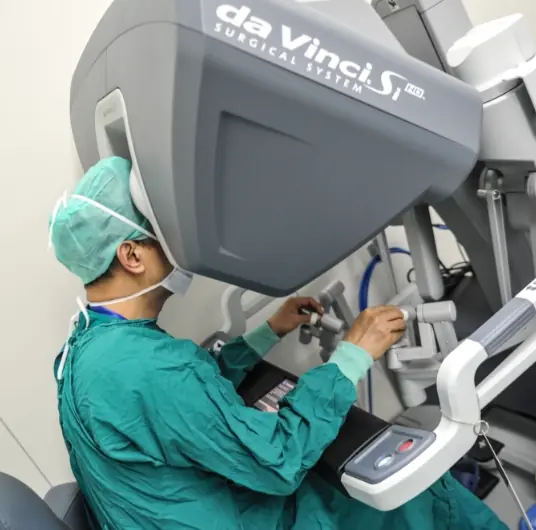PAVLOS PAVLAKIS UROLOGY
Robotic
Surgery

Robotic surgery is a minimally invasive surgical technique that utilizes tools from laparoscopic surgery. These tools are remotely controlled through a robotic system, which is entirely under the surgeon’s command.
Today, robotic surgery is widely practiced, especially with the da Vinci robotic system. This platform is used in over 80 countries worldwide. Approximately every 18.6 seconds, a surgeon somewhere around the world employs the robotic system for a procedure.
Greece has more than 10 robotic systems, and in the United Kingdom, over 180 hospitals have robotic systems available.
In the field of urology, surgeries related to prostate cancer, urinary bladder, and kidneys are often performed using robotic systems when available in the respective hospitals.

A few words about robotic-assisted prostate cancer surgery.
Typically, hospitalization lasts for 24 hours. The average surgical time ranges from one to three hours. After the procedure, the patient has a catheter, which will remain in place for about seven days. PSA monitoring is done every three months for the first two years, and then continues every six months


"Robotic Surgery,
Performed Procedures"
Robotic surgery is an advanced surgical method that utilizes robotic systems to perform procedures with high precision and accuracy. The procedures that can be conducted through robotic surgery include:
"Radical Prostatectomy for Prostate Cancer:
“Removal of the prostate and nearby lymph nodes for the treatment of prostate cancer.”
Lymph node dissection for staging of prostate cancer:
Removal of lymph nodes around the prostate to assess the spread of cancer.
Radical nephrectomy for tumor or simple for non-functional kidney:
Removal of an entire kidney for the treatment of malignant tumor or a non-functional kidney.
Partial nephrectomy for tumor or simple for non-functional kidney:
Removal of part of the kidney for the treatment of tumor or a non-functional kidney.
Removal of renal cysts:
Removal of cysts formed in the kidney.
Radical nephroureterectomy for tumors of the ureter or renal pelvis:
Removal of the ureter and renal pelvis to treat malignant tumor.
Simple nephrectomy for small or non-functional kidney:
Removal of a small or non-functional kidney.
Pyeloplasty for narrowing of the pelvi-ureteric junction:
Surgical procedure to expand or open the pelvi-ureteric junction.
adrenalectomy for benign or malignant tumors:
Removal of the adrenal gland to treat tumors.
Ureterolithotomy:
Surgical procedure for the removal of large stones from the ureter that cannot be treated endoscopically.
Radical cystectomy for malignant tumor:
Removal of the entire bladder to treat malignant tumor.
Radical retroperitoneal lymph node dissection for advanced testicular tumors:
Removal of lymph nodes in the testicular region to treat advanced cancer.

